Name Clementine Hunter | ||
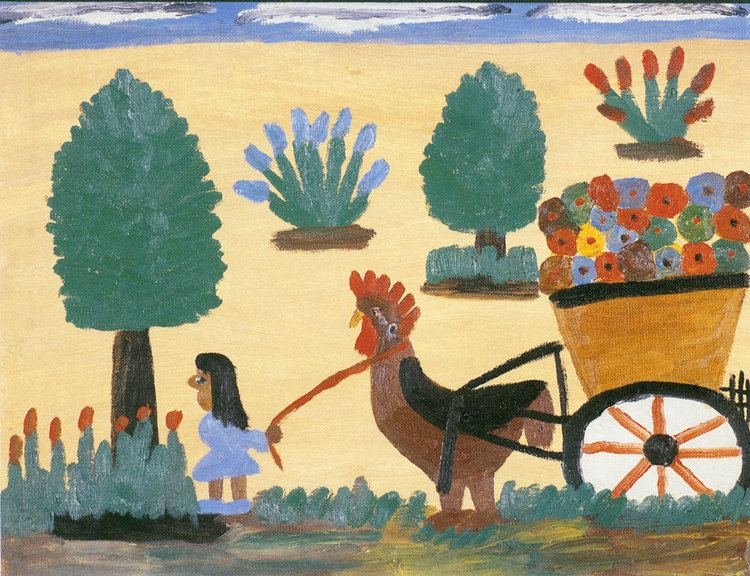 | ||
Died January 1, 1988, Louisiana, United States | ||
Clementine hunter history of forgery by tommy whitehead
Clementine Hunter (pronounced Clementeen) (late December 1886 or early January 1887 – January 1, 1988) was a self-taught black folk artist from the Cane River region of the U.S. state of Louisiana, who lived and worked on Melrose Plantation. She is the first African-American artist to have a solo exhibition at the present-day New Orleans Museum of Art.
Contents
- Clementine hunter history of forgery by tommy whitehead
- From angels to zinnias the art and style of artist clementine hunter
- Biographical details
- Career
- Hunters art
- Legacy and honors
- 2009 forgery case
- Selected Collections
- Studies and other related books
- References

Hunter was born into a Louisiana Creole family at Hidden Hill Plantation, near Cloutierville, in Natchitoches Parish, Louisiana; she started working as a farm laborer when young, never learning to read or write. In her fifties, she began painting, using brushes and paints left by an artist who visited Melrose Plantation, where she then lived and worked. Hunter's artwork depicted plantation life in the early 20th century, documenting a bygone era. She sold her first paintings for as little as 25 cents. By the end of her life, Hunter's work was being exhibited in museums and sold by dealers for thousands of dollars. Hunter was granted an honorary Doctor of Fine Arts degree by Northwestern State University of Louisiana in 1986. In 2013, director Robert Wilson presented a new opera about her: Zinnias: the Life of Clementine Hunter, at Montclair State University in New Jersey.
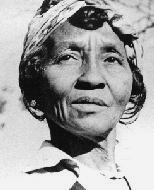
From angels to zinnias the art and style of artist clementine hunter
Biographical details
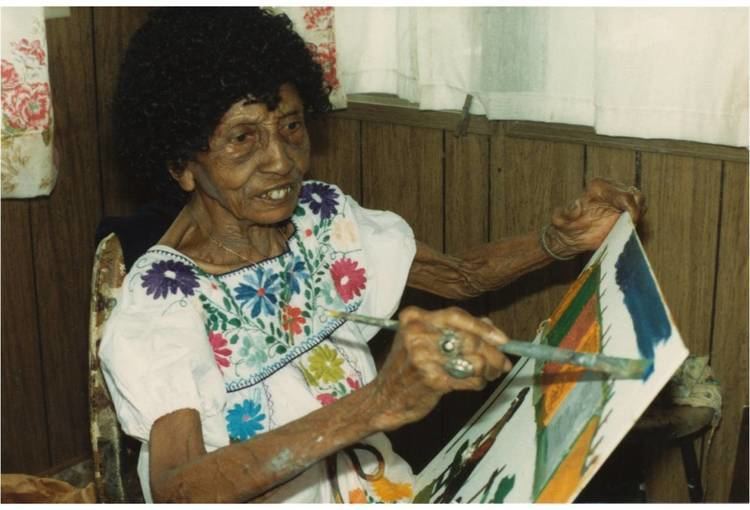
Born either in late December 1886 or early January 1887 Born about 1886, two decades after the end of the American Civil War, Hunter's grandparents were enslaved. She was the eldest of seven children of Creole parents at Hidden Hill Plantation, near Cloutierville in Natchitoches Parish, Louisiana. Hunter's given name was originally Clemence, but she changed it after moving to Melrose Plantation. Her mother was Antoinette Adams (d. 1905) and her father was Janvier (John) Reuben (d. ca. 1910), a field hand. Her parents were married on October 15, 1890. Her maternal grandparents were named Idole, who was formerly enslaved, and Billy Zack Adams. Her paternal grandfather was "an old Irishman" and her grandmother, "a black Indian lady called 'MeMe'" (pronounced May–May).

Hidden Hill was known as a harsh place to live and work, and local accounts say it was the inspiration for Uncle Tom's Cabin. It is now known as Little Eva's Plantation.
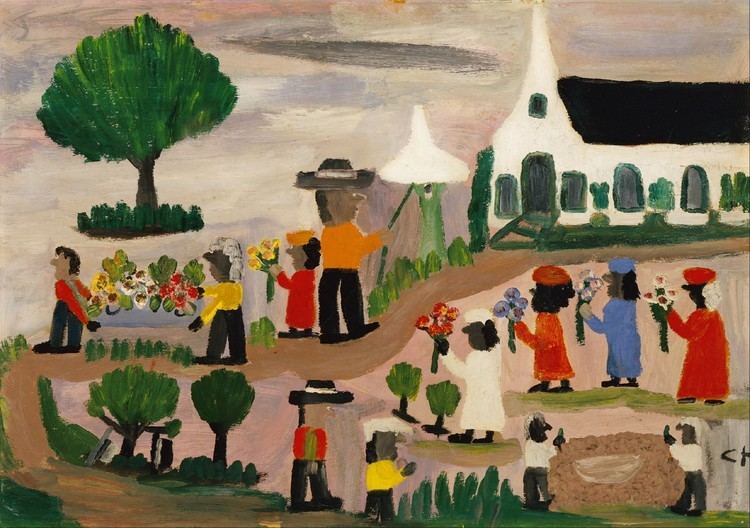
At the age of 15, Hunter moved to Melrose Plantation south of Natchitoches. She spent much of her life picking cotton and attended school for only 10 days, never learning to read or write.
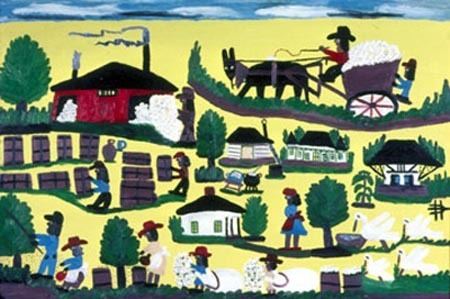
Her first two children, Joseph (Frenchie) and Cora, were fathered by Charlie Dupree, whom Hunter said she did not marry. Dupree died around 1914. Later she married Emmanuel Hunter, a woodchopper at Melrose, in 1924. The two lived and worked at Melrose Plantation for many years. Hunter worked as a field hand in her early years and as a cook and housekeeper beginning in the late 1920s. Hunter bore seven children, two stillborn. On the morning before giving birth to one of her children, she picked 78 pounds of cotton, went home and called for the midwife. She was back picking cotton a few days later. Hunter lived her entire life in rural, northwest Louisiana, never going more than 100 miles from home.
Career

Hunter was self-taught. Melrose Plantation became a mecca for the arts under the guidance of its owner, Cammie Henry. Numerous artists and writers visited, including Lyle Saxon, Roark Bradford, Alexander Woollcott, Rose Franken, Gwen Bristow, and Richard Avedon. Brushes and discarded tubes of paint left by New Orleans artist Alberta Kinsey after a 1939 visit to Melrose Plantation, were used by Hunter to "mark a picture" on a window shade, beginning her career as an artist.
Hunter gained support from numerous individuals associated with Melrose Plantation, including François Mignon, plantation curator. He supplied her with paint and materials, and promoted her widely. and James Register. With Mignon's help, Hunter's paintings were displayed in the local drugstore, where they were sold for one dollar. In her later years, Hunter co-authored "Melrose Plantation Cookbook" with Mignon.
On the outside of the unpainted cabin where she lived was a sign that read, "Clementine Hunter, Artist. 25 cents to Look." She produced between four and five thousand paintings in her lifetime.
Hunter's art
Hunter has become one of the most well-known self-taught artists, often referred to as the black Grandma Moses. Painting from memory, she is credited as an important social and cultural historian for her documentation of plantation life in the early 20th century. Her paintings portray picking cotton and pecans, washing clothes, baptisms, and funerals. Many of her paintings had similar subjects, but each one is unique. Hunter was noted for painting on anything, particularly discarded items such as window shades, jugs, bottles, and gourds and cardboard boxes. Her paintings rarely run larger than 18 by 24 inches.
Her work has generally been considered uneven, with her work from the 1940s to 1960 considered to be the best. It is admired for its palette and expressive force. She also produced a few quilts with themes similar to those expressed in her paintings.
Though she became a respected artist and is today considered a folk art legend, Hunter spent her entire life in (or near) poverty. In the 1940s, she sold her paintings for as little as a quarter. By the 1970s, she was charging hundreds of dollars for a painting. By the time of her death, her work was being sold by dealers for thousands of dollars. Hunter rarely titled her works, but when asked a title, would describe the subject of the painting.
One of the more well-known displays of Hunter's artwork is located in a food storage building called "African House" on the grounds of Melrose Plantation. (African House is often referred to as slave quarters, however the building was built for, and always used for food storage.) The walls are covered in a mural Hunter painted in 1955, depicting scenes of Cane River plantation life. When she completed the mural, a local newspaper ran the headline: "A 20th Century Woman of Color Finishes a Story Begun 200 Years Ago by an 18th Century Congo-Born Slave Girl, Marie-Therese, the original grantee of Melrose Plantation." Melrose Plantation was owned by a Louisiana Creole family for generations.
An article was published about Hunter in Look magazine in June 1953, giving her national exposure. A biography, Clementine Hunter: Cane River Artist (2012), was co-written by Tom Whitehead, a retired journalism professor who knew Hunter well. A director of the Museum of American Folk Art in Washington, D.C. described Hunter as "the most celebrated of all Southern contemporary painters."
Legacy and honors
Hunter was the first African-American artist to have a solo exhibition at the Delgado Museum (now the New Orleans Museum of Art). She achieved significant recognition during her lifetime, including an invitation to the White House from U.S. President Jimmy Carter and letters from both President Ronald Reagan and U.S. Senator J. Bennett Johnston, Jr..
Radcliffe College included Hunter in its Black Women Oral History Project, published in 1980. Northwestern State University of Louisiana granted her an honorary Doctor of Fine Arts degree in 1986. The following year, Louisiana governor Edwin Edwards designated her as an honorary colonel, a state honor, and aide-de-camp.
Hunter has been the subject of biographies and artist studies, and inspired other works of art. In 2013 composer Robert Wilson presented a new opera about her: Zinnias: the Life of Clementine Hunter, at Montclair State University in New Jersey.
2009 forgery case
In 1974, there were rumors that Hunter forgeries were being sold by William J. Toye in New Orleans. Decades later, the Federal Bureau of Investigations (FBI) investigated reports of forgery of Hunter's works and raided the home of Toye in September 2009. Toye, who was accused of selling forged paintings three times over the course of four decades, pleaded guilty in federal court on June 6, 2011. Others, including a relative of Hunter's and one of Henry's have forged Hunter's artwork as well. Whitehead says Toye's fakes were the best. His forgeries were painted on vintage board and his brush strokes and monogram were good replicas of Hunter's. But Hunter normally left smudges on the backs of her work and marred the edges, distinguishing marks missing from Toye's counterfeits. Whitehead said that unlike the work of European masters, which generally has well-documented provenance, Hunter produced thousands of paintings, which she sold from her front door. Also, collectors spending millions are more prone to research the history of their prospective purchases than folk art collectors spending much less. The price for Hunter paintings range between a few thousand dollars to $20,000 according to Whitehead.
